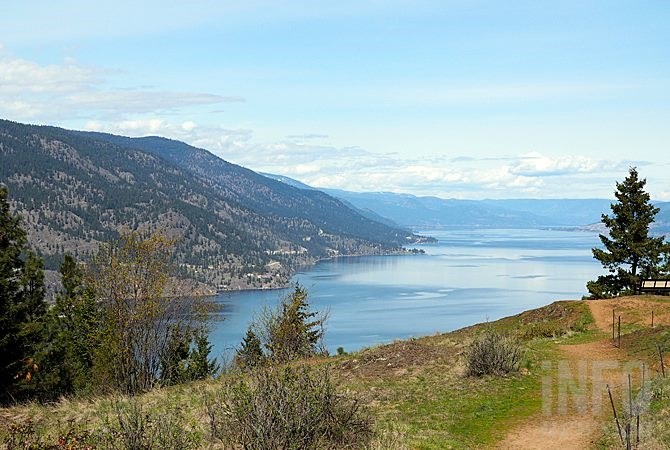
Looking out over Okanagan Lake from the top of Knox Mountain.
(ADAM PROSKIW / iNFOnews.ca)
October 29, 2023 - 6:00 AM
Although they share the same watershed, the international border has made the Okanagan vastly different from its US ‘Okanogan’ counterpart, says a UBCO professor.
Dr. Greg Garrard, Professor of Environmental Humanities at UBCO, is conducting research into what makes the Okanagan and Okanogan so vastly different.
“Brewster, Washington is where the Okanagan River meets Columbia and it's absolutely stunning,” Garrard told iNFOnews.ca. “But most Canadians don't think very much about the Okanogan down in the U.S.”
“How people think about it and how it's represented is really, really different. And so my curiosity was around, you know, is that cultural difference visible on the landscape in some way?”
Garrard said he was inspired to research the two regions after watching a grad student’s presentation on the the yellow-breasted chat in the South Okanagan.
The yellow-breasted chat is the flagship example of differences between the borders, Garrard said. Although the bird is scarcely found in the Okanagan, there are an abundance of them south of the border.
“It's kind of this endangerment caused by the border,” Garrard said.
Daisy Pullman, a graduate student working on the research project, said that this isn’t the only example of species disparity across the border.
“In BC the lynx is like not considered under threat and you're allowed to hunt and trap them for fur,” Pullman said. “In Washington they're considered highly endangered, and they have loads of protections, you're not allowed to hunt them. But they're the same lynx. They move back and forth across the border.”
The Confederated Tribes of the Colville Reservation in the US have trapped and relocated nine Canadian lynx in an attempt to boost numbers in the Okanogan.
“It's considered a failure because they go back,” Pullman said. “But the overall population health is probably pretty healthy but because they're only looking at Washington…. Especially as the climate changes they're going to carry on moving north, so I just find it really fascinating that the concern is 'oh we don't have enough lynx here', but they're fine.”
The international border that runs through the Okanagan and divides Syilx Nation land, has left around two thirds of the region under Canada’s jurisdiction, with the rest found in Washington state.
From this land divide, it appears that the Canadian side has fared far better economically than the Okanogan.
“Here in the Canadian Okanagan, there's been massive population growth in the last 50 years, particularly, and even more so in the last couple decades,” Pullman said. “Whereas in the U.S. it's been pretty stagnant, or even at some points it's declined in population.”
Kelowna, the Okanagan’s largest city, dwarfs the Okanogan’s population of just 40,000 residents. This difference is also mirrored in the economy.
“The economy here has grown a lot and the economy there is declining. They've had a lot of industries close,” Pullman said. “Tourism is a huge difference. There's just no real tourism in the U.S. Okanogan… there's some ski trails and I think there's some outdoor stuff but it's totally incomparable to the industry here.”
The Okanogan has also not been able to profit from the same fruitful agriculture industry as in BC. According to Garrard, the land is considered to be quite unremarkable in the US.
“The part that really interests me is that (the Okanogan) is completely inconspicuous to Americans,” Garrard said. “I doubt that anyone outside Washington, eastern Washington, would even have heard of it, whereas the Okanagan is kind of a big deal in Canada, it shows up in tourism magazines.”
Garrard pointed out that several films and books have been set in the Canadian Okanagan, yet there is no such thing in America. This, he said, is partially to do with the uniqueness of the Okanagan landscape in Canada.
“This kind of landscape is so rare in Canada, that's why it's valuable. America has lots of this kind of landscape. And so there's only a couple of wineries in Okanogan County, as opposed to dozens in the Okanagan.”
Jannatul Ferdous is another graduate student working on the research project. Her research has uncovered the visible ecological differences on the landscape.
“The US part is more like shrubland or grassland with little developed areas and agricultural lands,” Ferdous said. “But the Canada part is more diverse in terms of land use. And it is predominated by the coniferous or forest areas.”
The draw of the Okanagan, as one of the most sought-after destinations in BC, is what is putting a large amount of the habitat at risk from development, Garrard said.
“The thing that I find interesting about this… is the irony that, the fact that this place is so idealized in Canadian culture is the reason why it is under pressure as a habitat,” Garrard said.
The research Dr. Garrard and his students have conducted is still ongoing and is yet to be peer reviewed.
- This story was updated 12:21 p.m. Tuesday, Oct 31, 2023, to change "5,000 residents" to 40,000.
To contact a reporter for this story, email Georgina Whitehouse or call 250-864-7494 or email the editor. You can also submit photos, videos or news tips to the newsroom and be entered to win a monthly prize draw.
We welcome your comments and opinions on our stories but play nice. We won't censor or delete comments unless they contain off-topic statements or links, unnecessary vulgarity, false facts, spam or obviously fake profiles. If you have any concerns about what you see in comments, email the editor in the link above. SUBSCRIBE to our awesome newsletter here.
News from © iNFOnews, 2023